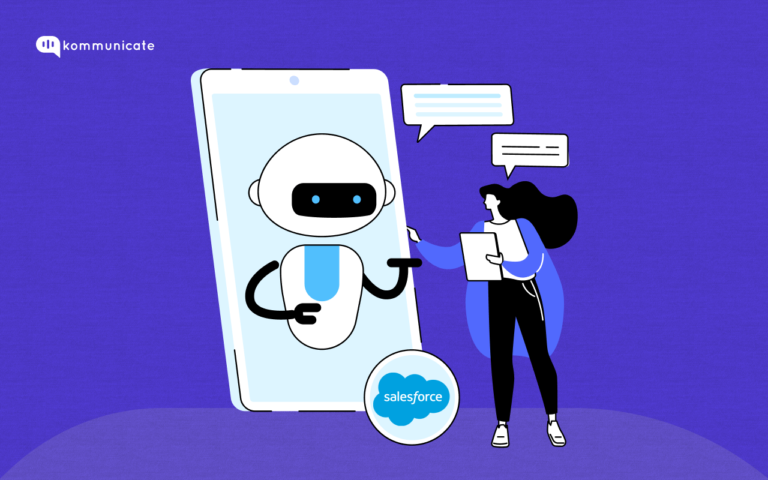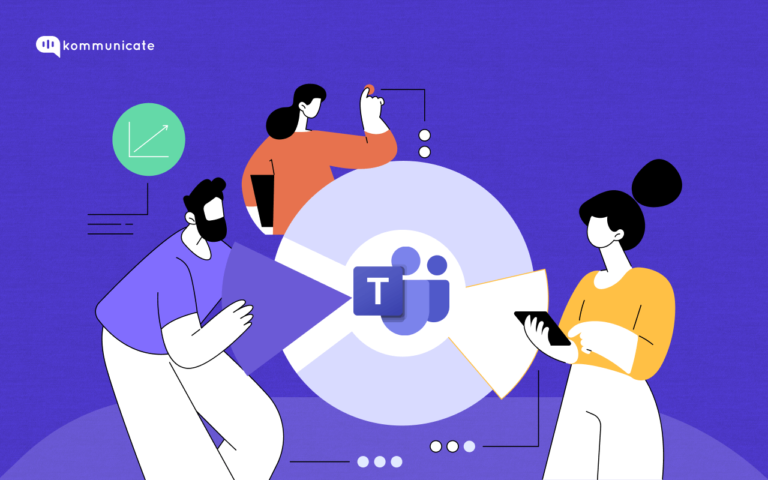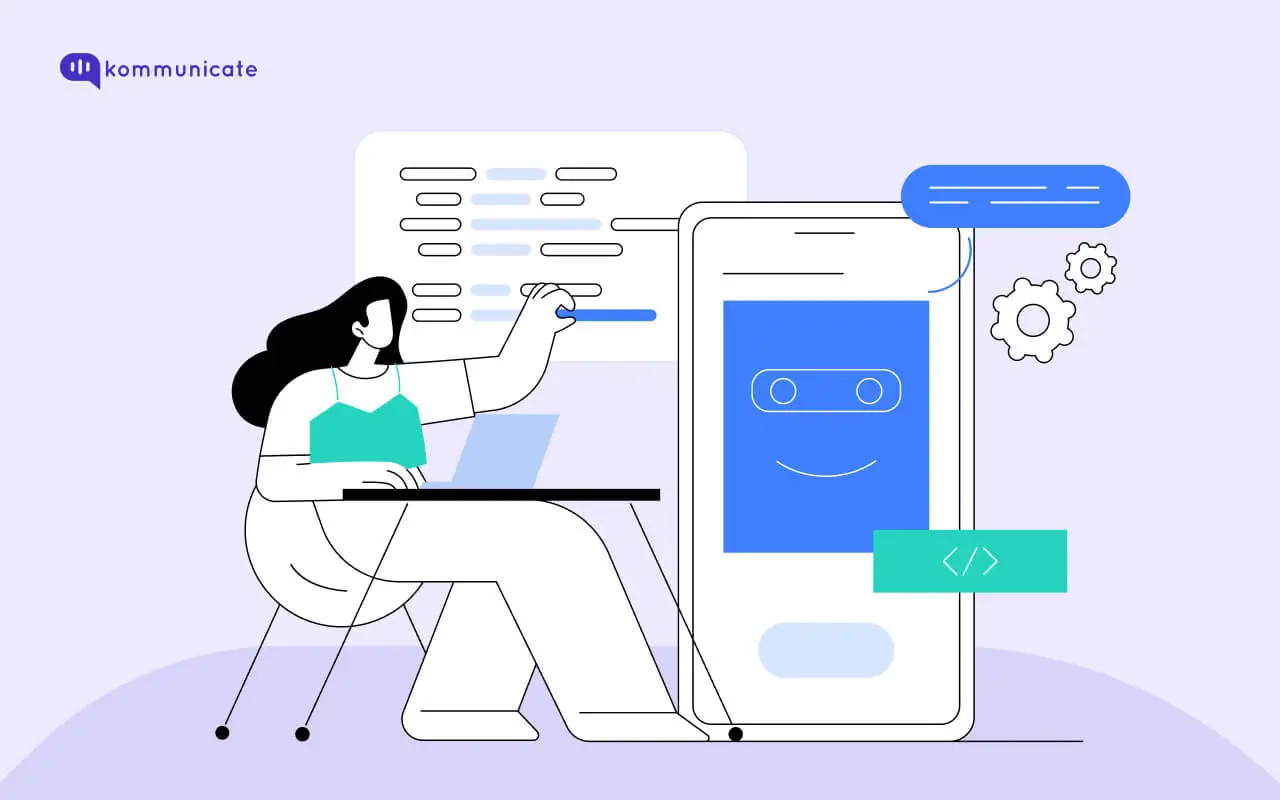Updated on April 12, 2024
As an enterprise, providing personalized, instant and round the clock support is the key to retain customers, and chatbots are one of the best ways to accomplish this. With NLP and machine learning capabilities, chatbots can understand customer inquiries, provide relevant information, and automate routine tasks.
This article includes:
- Benefits of chatbots for enterprises
- Things to consider before building your enterprise chatbot
- How to make a chatbot from scratch in 6 easy steps
- How to add a chatbot to your website
- How to activate the Chatbot on your website
- Why do enterprises need Chatbots?
- Industries using the Chatbots
- Frequently Asked Questions (FAQs)
As an enterprise, however, there are significant challenges that must be overcome to implement these chatbots. Overcoming the perception that coding expertise is needed is one of them. A survey by Forrester says that 63% of businesses feel lack of technical skills as a major barrier in adopting conversational AI technologies.
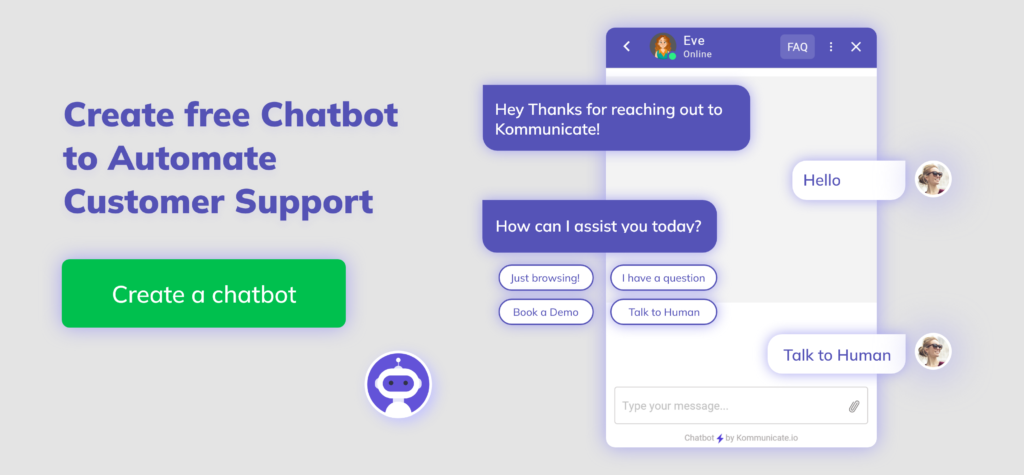
Despite the availability of having no-code low-code technologies, many enterprises still feel chatbot development is a code-intensive and complex process. An IBM study found that only 38% of the companies surveyed felt they had the time and the resources to build and maintain chatbots effectively.
Overcoming these challenges requires enterprises to upskill their workforces and leveraging user-friendly chatbot platforms that minimizes the need for coding expertise. And this is where no-code platforms such as Kommunicate truly shine.
Benefits of low-code chatbot platforms include rapid development cycles, reduced time-to-market, and lower development costs. Low code platforms allow you to iterate and deploy chatbots quickly, fostering agility and adaptability. They also play a big role in democratizing bot development, enabling users who may not be tech savvy to contribute to the process.
We also have more in-depth articles if you are interested in making chatbots for specific channels:
- Convert your Salesforce FAQ into a Chatbot
- Transform Any Website Into A Chatbot
- How Enterprises Can Convert PDFs/Documents into Chatbots with ChatGPT
We know that chatbots will help enterprises, and that no-code platforms are the future. But what are the real benefits of chatbots for enterprises. We will take a look in detail in the next section.
Benefits of chatbots for enterprises
- Chatbots streamline customer interactions, reducing the workload on the support team.
- Efficiency improvement, in the form of automation of repetitive tasks.
- Enhanced customer satisfaction and loyalty, thanks to instant responses.
- 24/7 availability – continuous support without human intervention.
- Integrate with existing systems for personalized experiences and data analytics.
Things to consider before building your enterprise chatbot
- Define clear objectives: Understand why you are builing your chatbot, and that it aligns with the business objectives.
- Find out the target audience: Define the user personas and their needs to tailor the chatbot’s interactions accordingly.
- Choose the right chatbot platform: Scalability, integrations and customization options should be considered before choosing a platform.
- NLP capabilities: See how much NLP sophistication is required based on complexity of user queries and interactions.
- Training data availibilty: Ensure access to high quality training data to train and refine the chatbot’s machine learning capabilities.
Enterprises can thus build sophisticated chatbots without the need to employ experienced developers. By taking away the complexities and providing intuitive interfaces, these tools empower non-technical teams to design, deploy and iterate on chatbot experiences seamlessly.
We will now explore how to build a chatbot in 6 easy steps
How to make a chatbot from scratch in 6 easy steps
Some chatbot development platforms use complicated workflow logic to create simple chatbots. They aim at advanced chatbot developers.
Kommunicate has developed (Kompose), a GUI bot builder based on natural language conversations for Human-Computer interaction. You don’t need any coding skills to master Kompose. It has a simple, intuitive, and easy-to-use interface.
Step 1: Go to the Bot integrations section
First, you need to login into your Kommunicate dashboard. If you do not have a Kommunicate account, you can sign up for free. Navigate to the ‘Bot Integration‘ under the “Bot Integrations” section click “Create a bot with Kompose( Chatbot Builder)”.
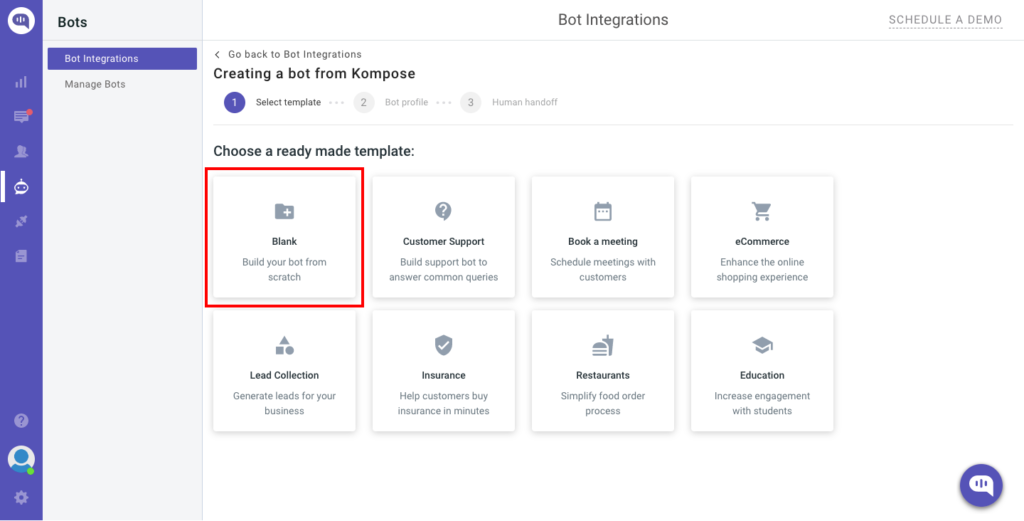
In the ‘Bot profile’ page, Set up your Bot by providing Bot Name & Language then ‘Save and proceed”.
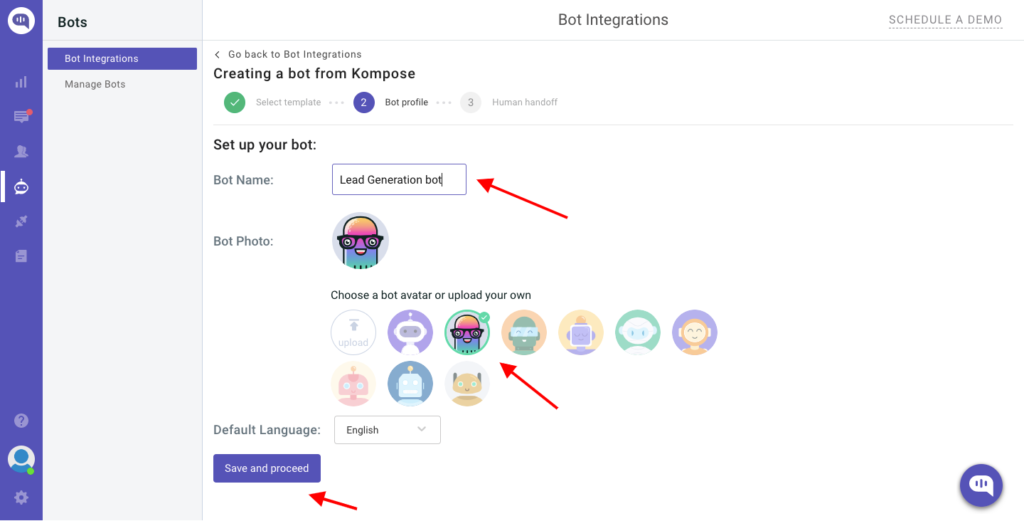
Once saved, it will be navigating to the next page ‘Human handoff’, enable or disable the “Automatic bot to human handoff:” setting, and click the ‘Finish bot setup’ button.
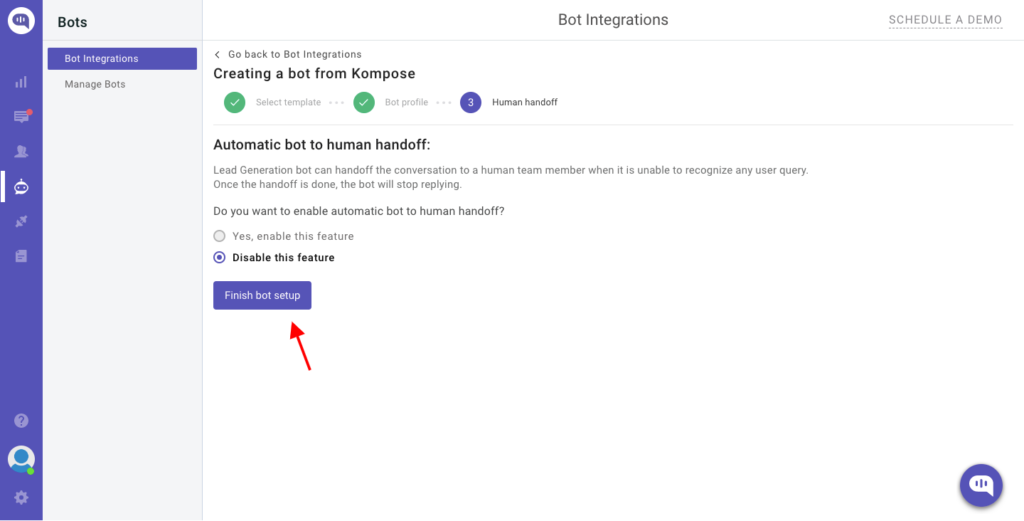
Step 2: Go to Manage Bots
After the bot setup is done, go to the Manage bots under Bot section. Click on the Go to Bot Builder
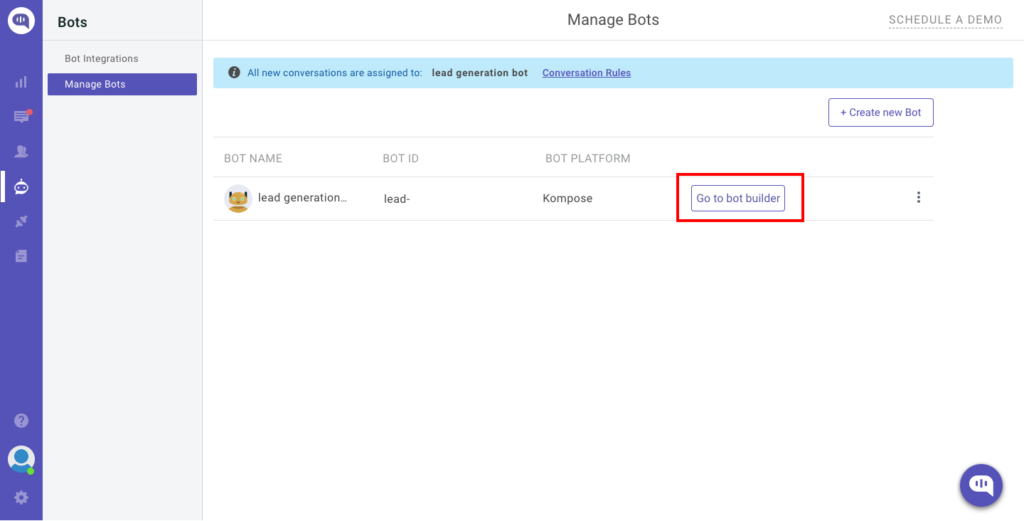
Step 3: Create a welcome message for your chatbot
After creating your first bot, you’ll be transferred to Kommunicate Flow Designer. By default, we’ve already prepared a basic conversation tree there to help you get going.
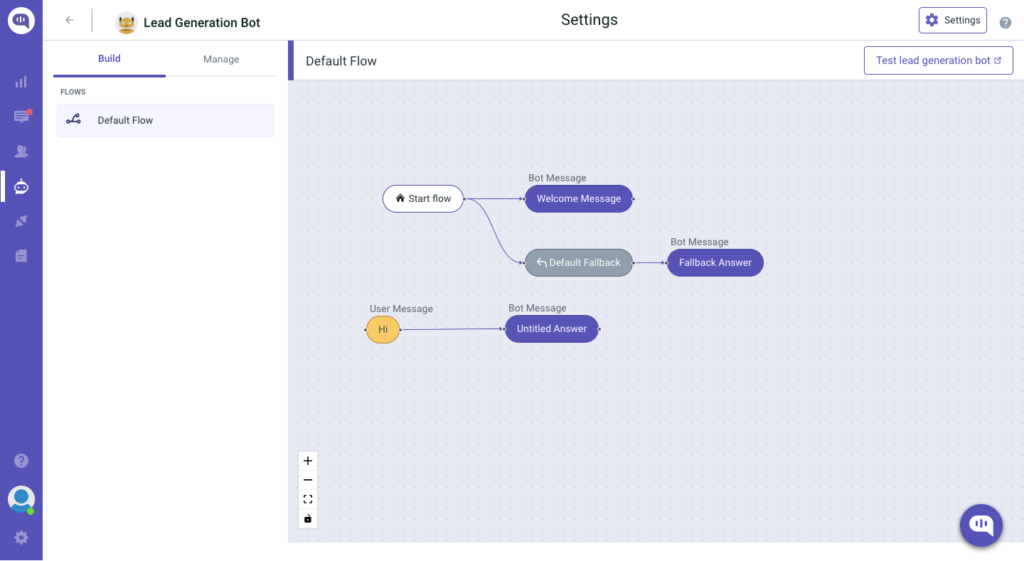
Click on the Bot response block to open its edit window. You can create the way you want.
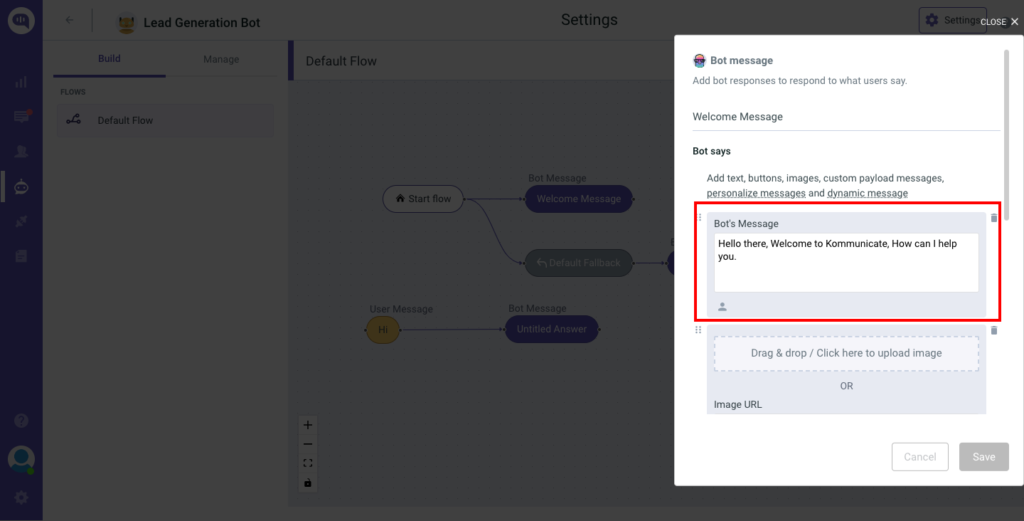
Note that, Welcome messages create the first impression, but they also maintain customer engagement and make them feel valued. An efficient bot greeting message also decides the conversational flow with visitors and giving a chance to explore the company’s products & features
Step 4: Add rich message button
You can set an interactive greeting message using the Kompose builder with the help of the Texts, Buttons, Images, or any other rich media type.
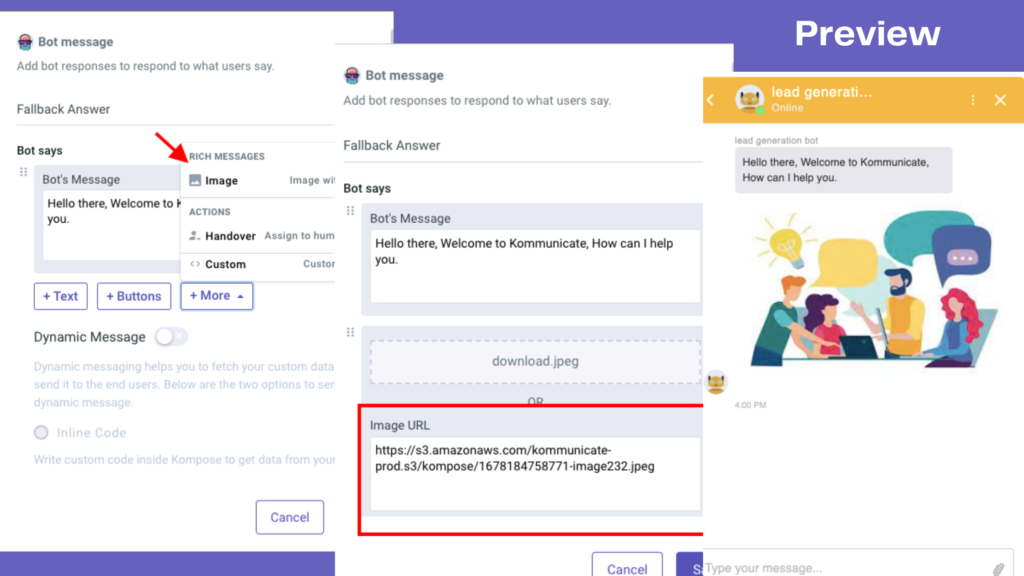
Step 5: Add quick response
Next, add a Quick reply response. Here, you can ask the user whether they want to sign up for your newsletter. You can encourage the user to do so by offering, for example, a coupon code.
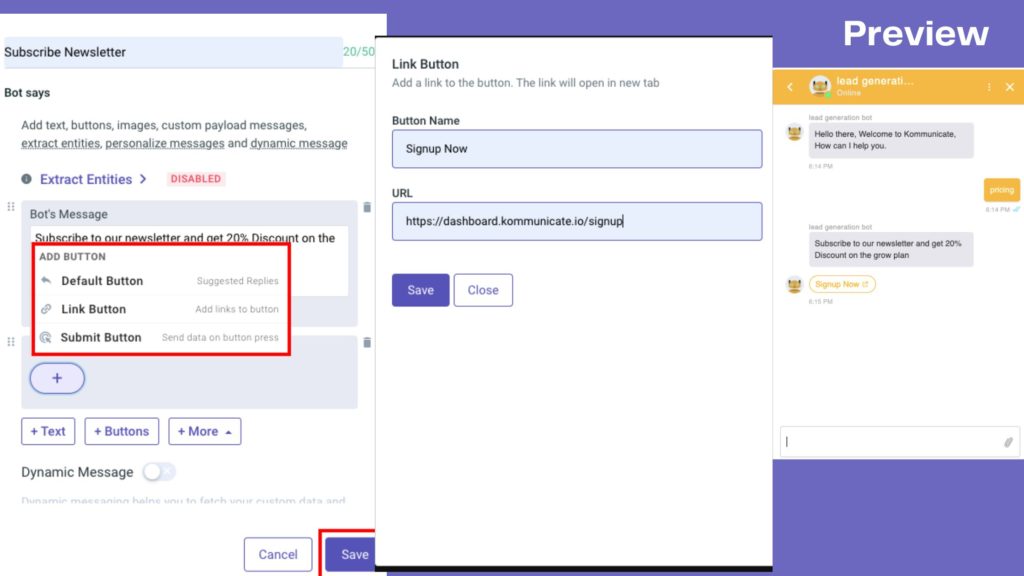
Step 6: Add Users Input
Now, it’s the user’s turn. To continue the conversation, choose the User input block from the main menu, and drop it after the Bot response block.
You don’t have to provide a comprehensive list of all possible variants. Because this chatbot employs an AI (machine learning) trigger, it will recognize a similar query and your customers’ intent even if what they’ve written doesn’t exactly match any of the queries on the list.
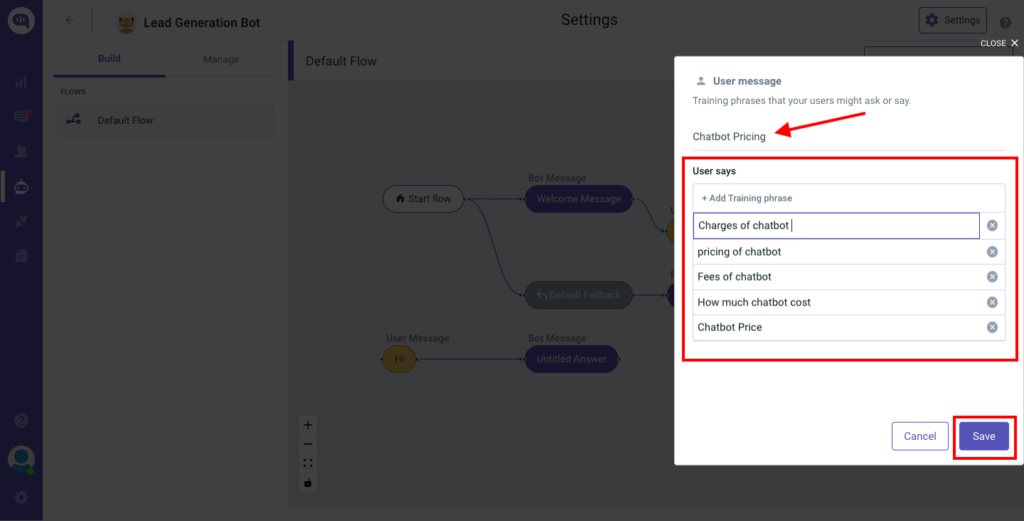
Note that, Kompose runs on powerful NLP, so the bot will be able to match intents for similar phrases as well. But as you know – the more the data – the better the accuracy. So make sure you add more phrases to fine-tune the bot.
Step 7: Test your chatbot
Once you have completed the welcome message and answers setup, the final step is to test your chatbot.
- Click the Test chatbot button to check the flow.
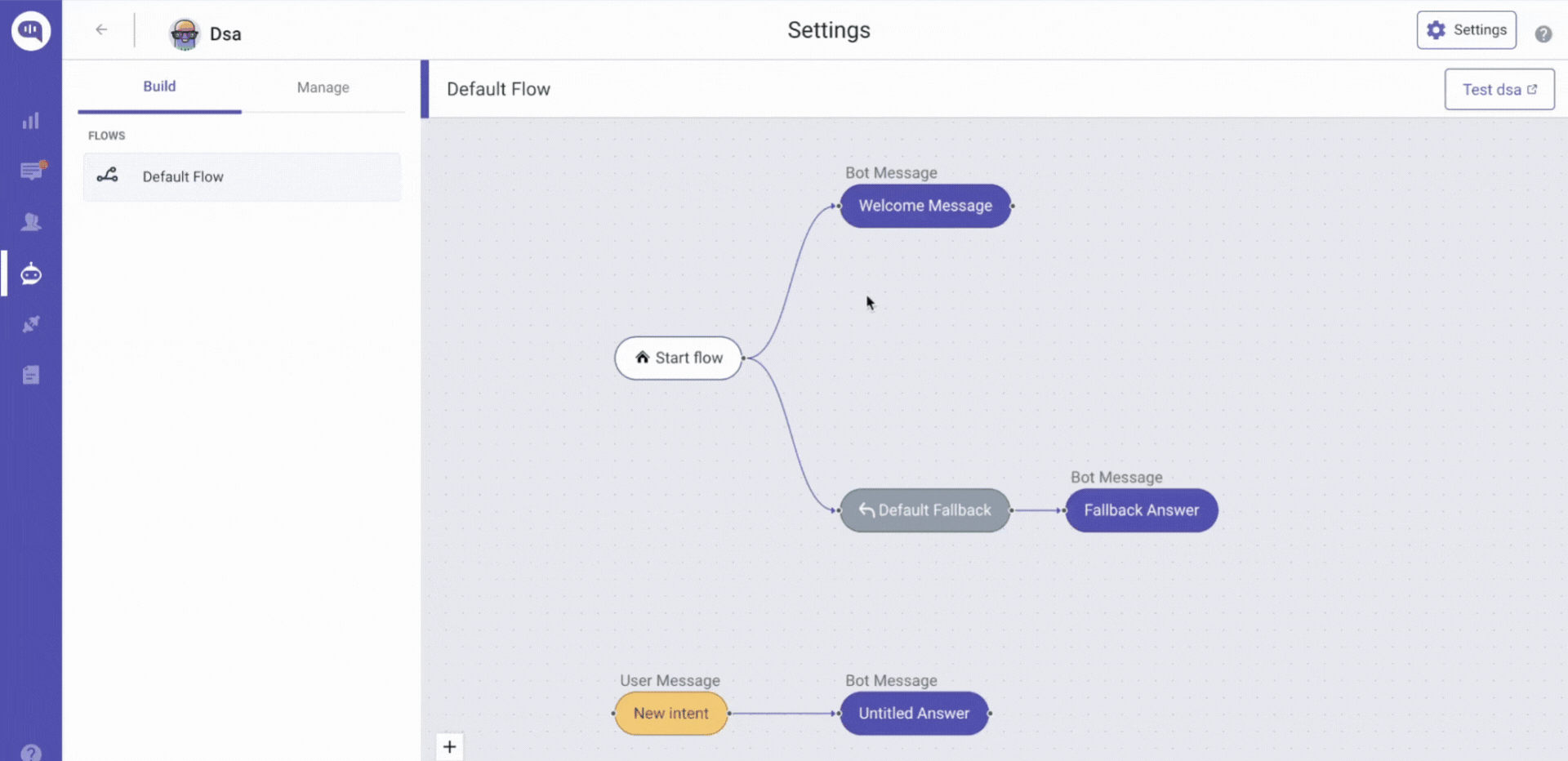
Click the buttons – Book a Demo, Give me a product tour (or type Book a Demo, Give me a product tour) that we created in the previous step. It will show that particular answer as a chatbot response to the user.
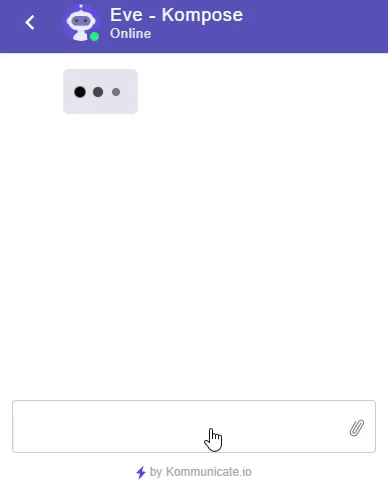
That’s it, Your chatbot is ready to get to work.
How to add a chatbot to your website
After creating the chatbot, the next step is to connect the chatbot to your website. You will get a short piece of Javascript code from the dashboard.
- Navigate to Dashboard → ⚙️Settings. Click on the Install section and click the Web tab and copy the JavaScript code.
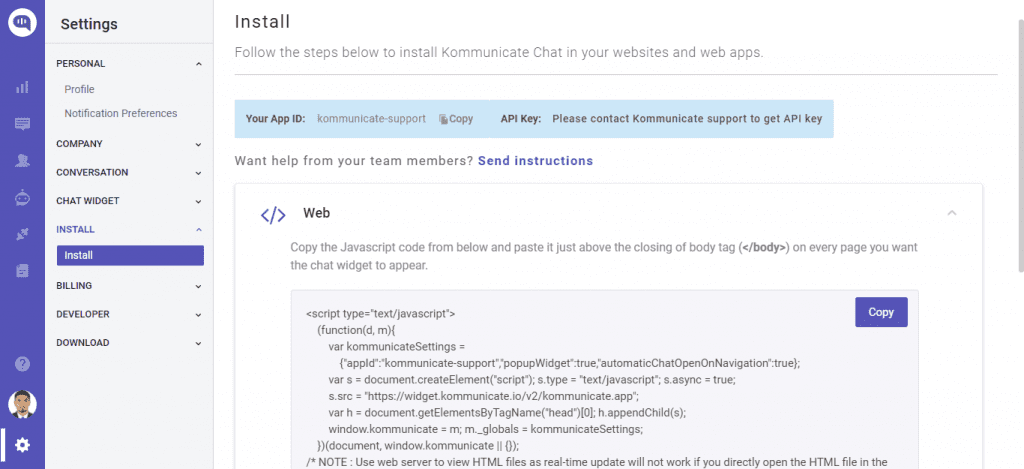
- Add the JavaScript code to your website’s code.
- Paste it just above the closing body tag (</body>) on every page you want the chat widget to appear.
That’s it. Now the Kommunicate live chat is now integrated with your website.
🚀 Read: CMS & Website Builders Installation
How to activate the Chatbot on your website
Once the Kommunicate live chat is added to your website, then you need to activate and assign all the incoming conversations to your chatbot.
You can do that from the Conversation rules section under ⚙️ Settings.
Enable Assign new conversations to the bot and select your newly configured bot from the Select a bot dropdown. Learn more about conversation rules here.

That’s it! Now the chatbot will be enabled on your website.
Test your chatbot periodically
Once you have created your chatbot, you would be able to test it from the Bot Integration section of the dashboard.
- Navigate to Dashboard → Click ‘Bot Integration’ then Select ‘Manage Bots‘ for the particular bot ‘Test this Bot’
There are a few cases that need to be considered while creating a bot, testing, and deploying the bot.
Proper Welcome Message: The bot should be able to introduce itself properly & what it can do, how it will assist the user.
Basic Salutation: Bot should be able to respond to Hi, Hello, Good Morning, Thank-you, kind of message, and small talks.
No cyclic loop: The bot should not get stuck in a cyclic look if a condition fails (repeatedly).
Fallback: If the bot is not able to handle/understand a user query then try to guide the conversation towards possible intents or handover to a human agent.
Typos: The bot should be able to handle basic typos so that the chatbot interaction flow doesn’t break abruptly.
In Kompose chatbot builder provides data for Bot intent analytics and Bot message analytics to analyze the bot intent count and the bot message flow. This will give more data to improve the performance of the chatbots constantly.
In case you want a video tutorial, here is one:
Why do enterprises need Chatbots?
When it comes to staying in touch with customers a lot of things have changed and it’s no longer business as usual not anymore. Operating a business needs you to become as effective as possible. That’s why chatbots have come into the picture and are quite popular these days. The purpose of Chatbots is to support and scale business teams in their relations with the customers. With the help of Chatbots, companies are saving a lot of money through various factors which is why many companies are adopting this technology in their work process.
Customer Support (24×7 support)
Customer support is the most important factor in business success and is a critical function for customer satisfaction. It also reduces the workload on the human agents. Chatbot connects users with customer service at any given time.
Thousands of users can interact with the chatbot without waiting for the human agents which will increase the engagement of website visitors with your business and increase leads.
🚀 Read: How Chatbots are Automating Your Customer Experience?
🚀 Read: Improve Customer Experience Using Automation

Zero-Waiting Time
A well-built chatbot can simultaneously have conversations with thousands of people answering the questions. Customers don’t wish to await assistance, any wait time can cause frustration and a negative impact.
Chatbots ensure that customers receive the moment response that they demand.
Personal Assistant
If you are selling products and services then chatbots would be your perfect personal assistant. Your customers may need help in selecting the right product and services. Users also seek advice when buying something from your website, such as dresses, watches, accessories, etc.
Chatbots can assist customers in getting the right product/service by providing suggestions and benefits of the product/service promptly.
🚀 Read more: The Role of Live Chat and Chatbots in Marketing
Higher engagement & Sales
It is important to keep your customers engaged with your products/services. Good chatbot performs all the primary business tasks, such as verifying customer-related information, replying to emails, and sending appropriate responses. This gives your team a lot of extra time which can be utilized efficiently towards more productivity.
A chatbot can initiate a conversation to promote an offer or update your customers about your latest product.

Industries using the Chatbots
As the popularity of chatbots increases, more industries are implementing chatbots, whether it is in their business operations, marketing, or sales activities. Some of the industries that started using chatbots are:
Education:
The education industry stands at the 3rd position in terms of benefits rendered by using AI at 14%. Universities are saving more money, cut labor costs, increased admissions, good response time, quick resolution to students, and making the onboarding process easier.
Chatbots can be also used as a learning guide and assist throughout the learning process. These are some of the benefits that are being savored by the educational industry.
Healthcare:
Chatbots can help strengthen the link between customers and medical professionals by scheduling appointments and sending reminders to patients, as well as collecting and analyzing health data.
🚀 Read more: Chatbots In Healthcare
E-commerce:
In this digital era, the growing acceptance of the internet as a shopping tool has led to the growth of the e-commerce market. More companies are starting their e-commerce business to set up their online presence and to stay ahead of the competition.
The use of chatbots in e-commerce is already a common sight. However, the tendency is that chatbots will be equipped with even more capabilities to turn into personal assistants and make the purchase experience smoother. Using the chatbots will reduce the Shopping cart abandonment rate and showcase new products and services.
🚀 Read: Ways to Transform E-commerce Customer Experience
Hospitality and Travel Agent:
This is another industry that can benefit from chatbots by further implementing/updating their system in terms of inventories, bookings, and pricing to mention some. It can shorten the overall time spent on routine processes.
Food industry:
In the fast-food industry, bots can be used to reduce the tasks currently occupied by humans, such as taking and confirming orders, receiving payments. It would decrease the number of mistakes and misunderstandings, as well as increase customer satisfaction from the service.
Banking:
Due to the chatbots banks can be transformed into 24/7 service entities that along with assistance, can provide analytical insights. It guides the user to create and update their account details online. The bots help businesses to promote new insurance & Loans. It can provide real-time financial advice to customers. Upgrading the card and client onboardings, are some of the banking chatbots.
🚀 Read: Ways to Transform Customer Experience in Banking
Wrapping Up
With technology advancement and digitalization, chatbot app services are playing a major role in businesses across various industries. With time, Chatbots will be the driving force to scale up any business, boost efficiency, improve customer relationship management, and reduce operational costs.
Nowadays every business owner and marketer is trying to create a chatbot for their website of their own. So it’s important to find a chatbot builder platform where no coding is needed as well as which shows the flow.
Also, note that chatbot can be integrated with messaging platforms like Facebook Messenger and the bot handles the visitor queries like Kompose bot builder.
🚀 Read: Integrate Facebook Messenger with Kompose Chatbot
To sum it up, it is pretty easy to make a chatbot using the Kompose bot builder. Go ahead and play around with Kompose and create your chatbots easily. No technical knowledge or coding is needed and you would be able to create your own chatbot within a few minutes.
Frequently Asked Question
How can I create my own chatbot?
There are two ways of creating your own chatbot. You can develop it from scratch if you are an expert in programming languages. You may also hire a development team to do it. Be informed that this is an expensive endeavor as it will require you to spend your time or engage an IT company to build the chatbot for you.
Alternatively, you can choose to try pre-built chatbot software. They do not require any coding and help build a chatbot with visual elements. It is also cost-effective since no IT company or their teams are required.
How do I make a chatbot for free?
There are several free chatbot software available on the internet that can help you build a chatbot for free. However, this software comes with heavy restrictions on branding, the number of chat sessions, and capabilities. Also, they cannot be scaled easily to meet the demands of a growing business. In short, you can build a chatbot for free, but do not have high expectations out of it.
How do I make the chatbot serve answers that users ask?
Chatbots can be programmed to serve canned responses to FAQs that customers ask. The FAQs can be populated and paired with appropriate responses. These sets of questions can also be updated from time to time to ensure that the chatbot can answer new questions that customers come up with.
Can the chatbot hand over the conversation to a human agent?
There are scenarios when a human agent intervention is required to resolve the customer’s issue. In such instances, the chatbot can be programmed to hand over the conversation to a human agent. The chatbot will look up the status of agents and pair the user with an available agent
Can the chatbot work on other messaging platforms?
Yes. Chatbots can work on several messaging platforms. There are chatbots available for almost all messaging platforms including:
- Chatbot for WhatsApp
- Chatbot for Facebook Messenger
- Chatbot for Line
How long does it take to launch the chatbot?
Almost instantly. If you are choosing to go with a customer support automation software like Kommunicate, you can create a chatbot and launch it on the same day without any programming or technical intervention.
However, if you are looking to create a unique chatbot with advanced capabilities, it might take longer. Write to support@kommunicate.io and we will return with the timeline.
At Kommunicate, we are envisioning a world-beating customer support solution to empower the new era of customer support. We would love to have you on board to have a first-hand experience of Kommunicate. You can signup here and start delighting your customers right away.



